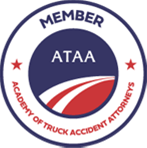A truck driver’s logbook is similar to what you may have heard regarding planes as their “black box.” It is a way to detail where and when the plane (or, in this case, truck) has been. A logbook keeps track of the hours driving to and from locations and the hours taken off between shifts for rest.
This logbook can be beneficial for several reasons. Reviewing the causes of a truck accident can provide evidence of whether or not the driver was negligent in the time they were driving leading up to the accident or if they were within the legal parameters that help drivers be alert vs. fatigued. Factoring in the driver’s logbook is imperative to review these cases.
What is the Federal Motor Carrier Safety Administration?
In addition to the laws drivers have to abide by while on the roadway, the Federal Motor Carrier Safety Administration also governs how truck drivers must carry out their day-to-day duties involving driving and their cargo.
Hours of Service refers to the maximum amount of time that drivers are permitted to be “on the clock” in terms of driving time, rest time, and more. The Hours of Service regulation inhibits negligence due to overworked and fatigued drivers and requires them to get adequate rest in between trips to ensure they are alert and functional.
What are the Hours of Service?
For property-carrying drivers (in this example, we will use the guidelines for property-carrying drivers vs. passenger-carrying drivers), the rules are as follows;
- Drivers may operate for a maximum of 11 hours after ten consecutive hours off duty.
- Drivers may not operate past the 14th consecutive hour after returning to driving duties, following ten hours of consecutive rest time.
- Drivers must take a 30-minute break when they have operated for a period of eight consecutive hours without a break.
- Drivers are allowed to extend the 11-hour or 14-hour maximums when faced with adverse driving conditions or inclement weather.
- Drivers may not operate more than 60/70 hours in ⅞ consecutive days.
- Drivers may restart a ⅞ consecutive day period only after taking 34 or more hours off duty.
How Can a Logbook Prove a Driver Wasn’t Within the Hours of Service?
Drivers fill out their logbooks and are mandated to do so. After an accident, these logbooks can be reviewed to determine if the driver was within the required hours on or off duty. If they violate the federally mandated Hour of Service, this can indicate that they were negligent and that caused the accident.
Mileage is also included in a logbook, so if the hours of service are correct and within standards, but the miles traveled don’t match up to the hours worked, this can lead to further investigation. By closely reviewing the miles logged, it can indicate that the logbook was tampered with or speeding was involved, which could also lead to negligent findings on behalf of the driver.
What is a Driver’s Vehicle Inspection Report?
Similar to a logbook, drivers of trucks weighing more than 10,001 pounds are required to fill out an inspection report at the end of each day. The Driver’s Vehicle Inspection Report DVIR can also be helpful in establishing negligence in an accident.
Some of the critical items that need to be inspected daily are steering systems, brakes, tires, wheels, rims, windshield wipers, horns, rearview mirrors, emergency equipment, and more. If the driver is in violation of accurate DVIR or the daily DVIRs are non-existent, this could also qualify as a way to determine whether or not the driver was acting negligently when operating the truck before the accident.
Why is Driver Fatigue an Important Issue?
Due to strict deadlines, drivers are susceptible to pushing the limits of when they should be resting vs. when they are driving to get to their destination on time. What this can lead to is driver fatigue or drivers that are much more prone to causing accidents.
An experienced truck accident lawyer can dig into the information and ensure that the driver was operating within the standards they are held to through the FMCSA. Suppose it is found that the driver ignored the Hours of Service or other mandated regulations. In that case, they can utilize this information to prove negligence on behalf of the driver and, in some cases, on behalf of the trucking company that employs the driver.
Get the Defense You Deserve
Whether you are the driver of the truck involved in an accident or the driver of the car that collided with the truck, you deserve to be protected. Truck accidents have exponentially greater damages and injuries due to the size of the vehicles involved. By reviewing a driver’s logbook, negligence can be proven to exist, or it can also be used to determine that the driver was within federal standards and, therefore, not negligent.
Call our office today at 803-219-8870 to speak with an experienced and passionate defense lawyer that is capable and compassionate. We work tirelessly for our clients to defend them and ensure they are protected from false information and, when necessary, receive the compensation they rightfully deserve.












